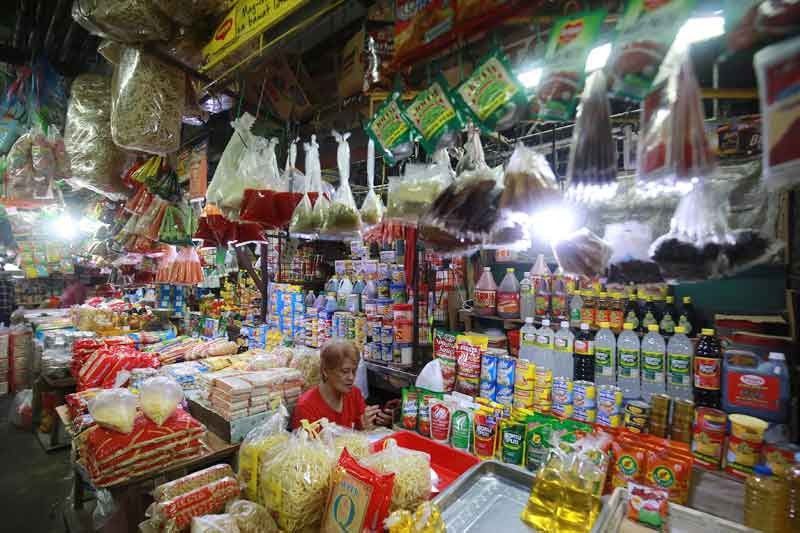Inflation surges to 6.4%, highest in 9 years

MANILA, Philippines — The country’s headline inflation hit a nine-year high in August, spiking by 6.4 percent year-on-year and registering higher annual inflation across a majority of regions, data from the Philippine Statistics Authority (PSA) showed Tuesday.
The August figure is higher than the 2.6 percent registered in the same month last year and the 5.7 percent inflation in July. Core inflation was up 4.8 percent.
This brings year-to-date headline inflation to 4.8 percent.
Inflation in the National Capital Region (NCR) went up by 7 percent in August, compared to the 3.3 percent hike in the same period last year. This is also higher than the 6.5 percent increase last month.
The PSA reported that annual inflation in Areas Outside NCR (AONCR) grew at 6.2 percent, compared to the 2.4 percent last year and the 5.5 percent last month.
“Fourteen regions recorded higher annual inflation in August compared with their previous month’s annual rates. Among the regions in AONCR, the highest annual mark-up of 9.0 percent was observed in Region 5 (Bicol), while the lowest annual rate of 3.6 percent remained in Region 3 (Central Luzon),” the PSA said.
Other regions with higher annual inflation are Region 1, Ilocos (6.8 percent); Region 2, Cagayan Valley (7.1 percent); Region 4-A, Calabarzon (6.1 percent) and Region 4-B, Mimaropa (4.5 percent); Region 6, Western Visayas (7.4 percent); Region 8, Eastern Visayas (6.1 percent); Region 9, Zamboanga peninsula (6.4 percent); Region 10, Northern Mindanao (6.1 percent); Region 11, Davao Region (7.1 percent); Region 12, Soccsksargen (7.9 percent); Region 13, Caraga (4.8 percent); Autonomous Region in Muslim Mindanao (8.1 percent).
In contrast, inflation in Region 7 (Central Visayas) saw slower growth at 6.3 percent from last year’s 6.5 percent, while inflation in the Cordillera Administrative Region remained unchanged at 4.1 percent.
Meanwhile, the PSA reported that the increase in the headline inflation at the national level was driven by the annual increase in a number of commodity groups, led by alcoholic beverages and tobacco, which spiked at 21.6 percent.
This was followed by food and non-alcoholic beverages with an 8.5 percent growth; furnishing, household equipment and routine maintenance of the house, 3.5 percent; health and restaurant and miscellaneous goods and services, 4.0 percent; and recreation and culture, 2.4 percent.
Economic management
But Malacañang assured the public yesterday that the government is doing its best to address the rising inflation.
Amid the rising cost of basic commodities, presidential spokesperson Harry Roque Jr. urged the public to be more understanding as the economic managers are working double time to address inflation.
“The administration is taking steps to address the challenges, particularly rising prices, faced by Filipino families,” he said.
“The President’s economic team continues to monitor inflation with vigilance as government takes action to assist the poor while keeping the macro-economy stable,” Roque said.
For its part, the inter-agency Development Budget Coordination Committee (DBCC) is considering to revise its inflation assumptions for this year, following the higher-than-expected inflation footprint last August, the Department of Budget and Management (DBM) said yesterday.
The DBCC, which is composed of the DBM, Department of Finance (DOF), National Economic and Development Authority (NEDA) and the Bangko Sentral ng Pilipinas (BSP), will meet after their scheduled Philippine economic roadshow in London later this month.
“We’ll convene the DBCC to see if there’s a need to reflect the new developments,” Budget Secretary Benjamin Diokno said in an interview.
According to Diokno, members of the DBCC will discuss the latest developments in the economy and study possible revisions to the council’s projections on inflation this year, which is currently at 4.0 to 4.5 percent.
“We’ll revise the inflation target, of course, upward. We don’t know yet. The one who proposes that is usually BSP,” Diokno said.
Diokno said the inflation results in August should serve as a “wake-up call” for policymakers to pass the rice tariffication bill.
The secretary also continued to express optimism that inflation would taper off in the last quarter of the year and go back within the two to four percent target of the government.
The BSP said in a statement that the higher-than-expected inflation outturn for August could be attributed to the impact of supply-side factors owing to recent weather disturbances and the continued uncertainty in rice supply.
“Moreover, energy and transport prices have contributed to the uptick in inflation,” the BSP added.
The BSP also said it continues to monitor the outlook for inflation, along with the public’s inflation expectations and evidence of second-round effects, all of which would be considered closely in the assessment of the monetary policy stance at the September Monetary Board policy meeting.
“The BSP reaffirms its strong commitment and readiness to take all necessary policy actions to address the threat of high inflation and deliver on its primary mandate of price stability,” it said.
The BSP added that it supports the implementation of government coordinated non-monetary measures to address the supply-side nature of current inflation pressures.
Meanwhile, the NEDA said the higher than expected inflation for August calls for a committed effort from agencies in the agriculture sector to boost output and introduce policy reform needed to bring down prices of agricultural products.
“The government, particularly the Department of Agriculture, must act quickly and fervently with sound judgment to ease the increasing prices of agricultural commodities, which are the main drivers of inflation,” Socioeconomic Planning Secretary Ernesto Pernia said.
Price adjustments on food and non-alcoholic beverages were higher than the 2.9 percent inflation from a year ago and the 7.1 percent in July.
“While the government’s economic team expected inflation to peak in the third quarter before tapering off towards the latter part of the year, inflation in August is largely beyond the median market forecast. That is why we remain steadfast in putting forward measures that will address prices, especially for food,” Pernia said.
Damage to agriculture brought about by the southwest monsoon and Typhoon Karding in Ilocos, Cagayan and Cordillera regions amounted to P33.5 million, thus taking a toll on the prices of agricultural commodities.
“The rehabilitation of the disaster-stricken agriculture areas must be highly prioritized,” Pernia said.
The NEDA also emphasized the need to boost the country’s rice production as palay production growth slowed down to 1.68 percent from 12.06 percent during the first half of last year.
In addition, the country’s total rice stocks inventory of the National Food Authority further declined to 1.9 million metric tons as of Aug. 10. This was around 15 percent lower than the levels in the previous month.
Pernia also cited the weak performance of the fisheries sector, with output of fisheries and other products falling by 2.14 percent and 0.44 percent in the first half of this year. This was mainly caused by reduced trips of fishermen, fish kill and destruction of fish cages, aside from weather disturbances.
The socioeconomic planning secretary reiterated the passage of the amendments to Republic Act 8178 or the Agricultural Tariffication Act, which is a crucial step in reforming the agriculture sector over the medium and long term.
Food reforms
Economic managers are moving for the implementation of a number reforms directed at addressing growing food inflation, prompted by the unexpected rise in headline inflation.
In a meeting yesterday, members of the country’s economic development cluster composed of the DOF, DBM, NEDA, Department of Trade and Industry (DTI), Department of Agriculture (DA), Department of Justice (DOJ), BSP, Bureau of the Treasury (BTr) and some members of the National Food Authority (NFA) Council agreed that reforms for reducing food prices need to be implemented immediately.
“The highest contributors to inflation in August are electricity, gas and fuels, fish, rice, personal transport, vegetables and meat. Reforms in agriculture will continuously be implemented to address the supply issues causing the rise in food prices,” the economic managers said in a joint statement.
They said this is supported by the lowest regional inflation rate recorded in food-abundant and agriculturally productive Central Luzon (Region 3) at 3.6 percent.
“A committed effort from government in the agriculture sector to boost supply of key products and introduce policy reforms will bring down prices for all Filipino families,” the economic team said.
Among the reforms to be implemented is the replication of the issuance of certificates of necessity to allow imports on fish to be distributed in the wet markets in Metro Manila and to other markets of the country by the DA.
On rice supply issues, the economic team has ordered the NFA to release 4.6 million sacks of rice available to markets.
“We also expect approximately two million sacks of rice previously contracted to be delivered before the end of September,” the economic team said.
In addition, the NFA Council authorized the importation of five million sacks that will be arriving over the next one and half months and another five million sacks to be imported early next year.
Some 2.7 million sacks of rice will be allocated to Zamboanga, Basilan, Sulu and Tawi-Tawi to address reported shortage in these areas.
Also, harvest has started in many parts of the country, with the projected harvest for 2018 of 12.6 million metric tons of rice the equivalent of 252 million sacks.
Economic managers have agreed to recommend to the President the issuance of a directive to further simplify and streamline the licensing procedures for rice imports of the NFA.
They are also urging the Senate to immediately pass the Rice Tariffication Bill within the month.
The bill amends Republic Act No. 8178, or the Agricultural Tariffication Act of 1996, which will pave the way for the replacement of the quantitative restrictions on rice imports with tariff.
They added that a monitoring team for surveillance of rice from ports to NFA warehouses and retail outlets will be formed by the DTI, NFA, Philippine National Police (PNP), National Bureau of Investigation (NBI) as well as farmer groups.
On chicken, the DA and DTI will convene poultry producers and set up public markets where producers can sell directly to end customers to reduce the gap between the farm gate and retail prices. The DA will provide cold storage for this purpose.
Among other reforms pushed by economic managers is the opening of importation of sugar to direct users to moderate cost to consumers by the Sugar Regulatory Administration (SRA); the prioritization of the release of essential food items in the ports by the Bureau of Customs.
“The spike in the prices of vegetables was attributed to seasonal weather conditions. We will see relief in this area after the typhoon season,” the economic managers said.
Finance Secretary Carlos Dominguez III said these proposed reforms “should start taking effect this month.”
BSP deputy governor Diwa Guinigundo said if these measures are implemented in September, the 6.4 percent inflation rate in August “will be the peak.”
The government’s economic team previously announced that inflation was expected to peak in the third quarter before tapering off towards the latter part of the year, and then fall within the government’s target by next year.
“However, inflation in August was beyond the median market forecast. We remain steadfast in putting forward and accelerating these measures that will address food prices for all Filipinos,” the economic managers said.
Leni’s appeal
Vice President Leni Robredo reiterated yesterday her appeal to the government to increase the P200 monthly cash subsidy being provided to poorest Filipino families to help them cope with the continuing rise in prices of commodities and services.
Robredo also lamented that around four million households have yet to receive the subsidy. – With Mary Grace Padin, Christina Mendez, Helen Flores, Roel Pareño, Paolo Romero, Marvin Sy, Jess Diaz, Sheila Crisostomo
- Latest
- Trending



























